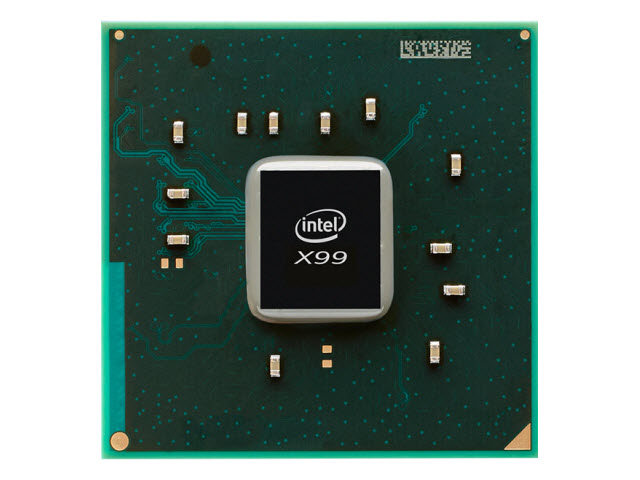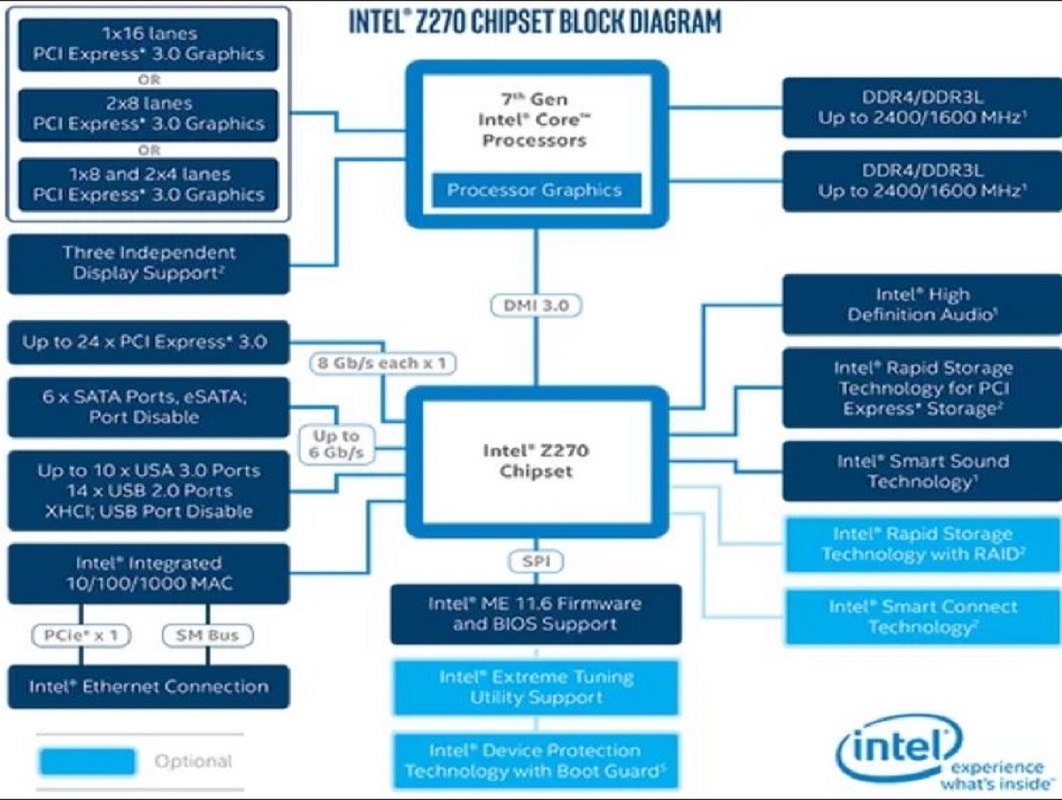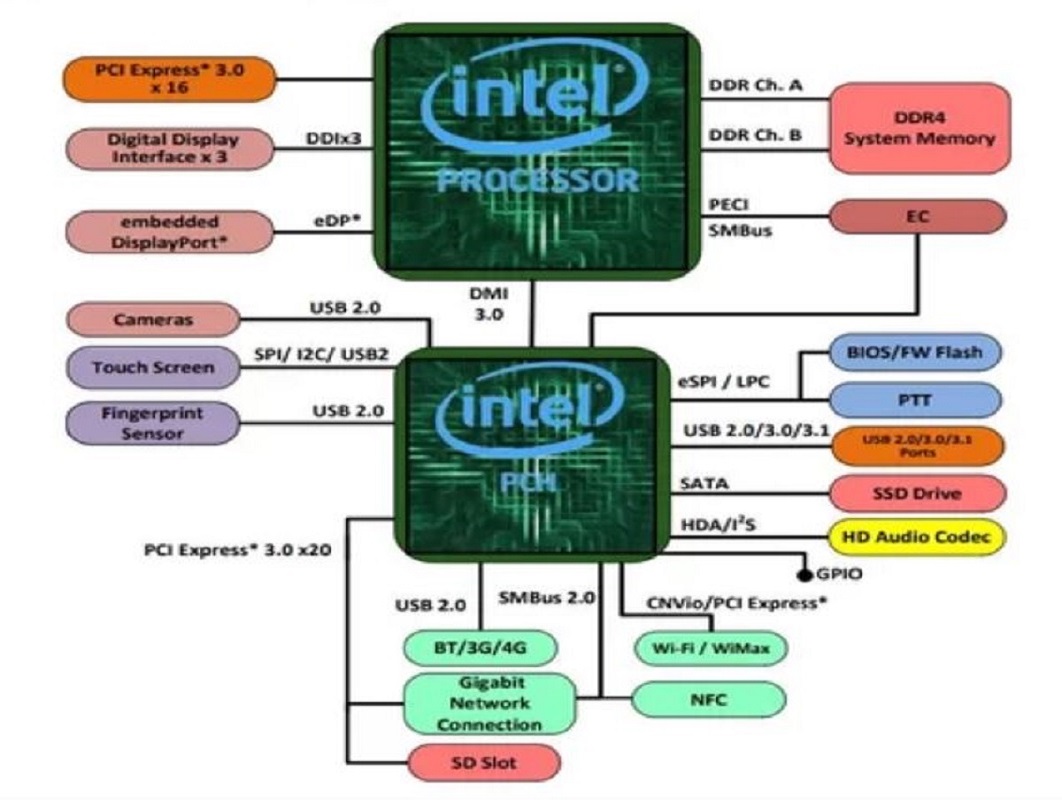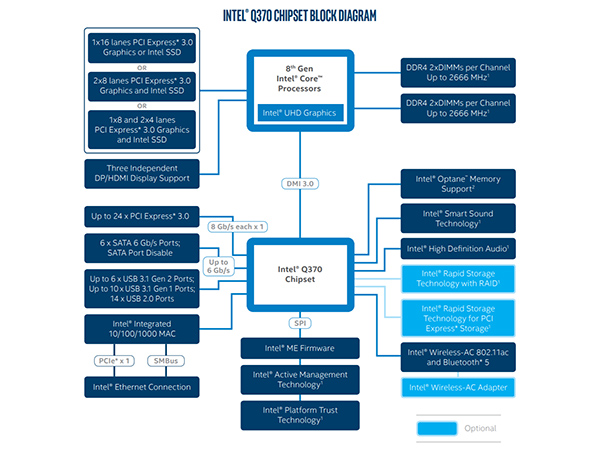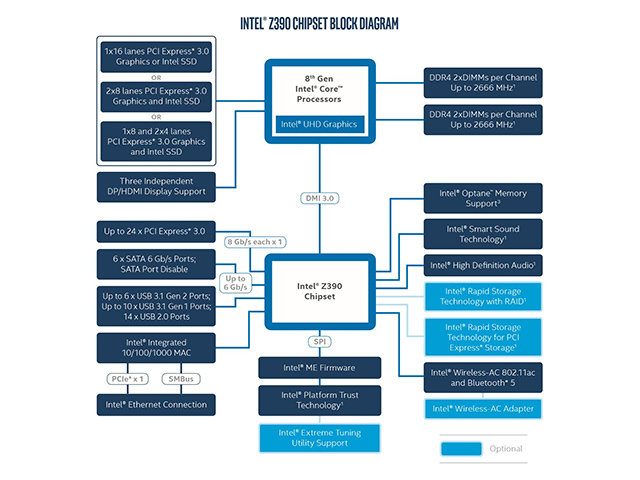History of Intel Chipsets
Intel's X79 And X99 Chipsets: The Second Gen. Enthusiast Platform
In late 2011, Intel replaced LGA 1366 with the LGA 2011 interface and X79 PCH. A major advantage of this new platform was the integration of PCI Express control into the CPU, enabling up to 40 lanes of third-gen connectivity. Compatible host processors boasted quad-channel memory controllers, too, increasing bandwidth compared to the prior triple-channel design.
The X79 chipset was equipped with an additional eight lanes of PCIe 2.0 to accommodate add-in cards. It also offered six SATA ports (two SATA 6Gb/s and four SATA 3Gb/s), 14 USB 2.0 ports, and a PCI bus.
While X79 was popular with enthusiasts, Intel later created five business-oriented chipsets for LGA 2011 Xeons: C602, C602J, C604, C606, and C608. They primarily differed from X79 by providing access to technologies like vPro. With the exception of C602J, they also supported SAS drives.
Intel's high-end desktop platform was later rejuvenated by the X99 chipset, which supported Intel's Haswell-E and Broadwell-E CPUs. The X99 PCH added six ports of USB 3.0 connectivity and a SATA 6Gb/s controller armed with 10 ports. A business-oriented chipset called C612 was also created based on the X99 PCH.
Main new features:
- PCH (Platform Controller Hub)
- Quad-Channel Memory Controller
- DDR4 Memory
Processors from this era:
- 2nd-, 3rd-, 4th-, and 5th-Gen Core i7 and Xeon Processors
MORE: Best CPUs
Get Tom's Hardware's best news and in-depth reviews, straight to your inbox.
MORE: The History Of Intel CPUs
MORE: The History Of AMD CPUs
Intel's 8- And 9-Series Chipsets
Intel's next batch of consumer chipsets was launched alongside the fourth generation of Core processors, and included H81, H87, Z87, B85, Q85, and Q87. These shared many features with the 7-series Platform Controller Hubs, but extended USB 3.0 support. Except for H81 and B85, all 8-series platforms exposed six USB 3.0 ports (B85 was limited to four and H81 only had two). SATA support was also extended: all six ports on Z87, H87, and Q87 operated at up to 6 Gb/s. Intel later released the H97 and Z97 chipsets to support its Broadwell CPUs. The 9-series added support for PCIe-based M.2 devices, but was otherwise identical to the 8-series.
Notably, the 8-series chipsets were the first from Intel to do away with PCI altogether. Although PCI slots can still be found on certain motherboards, their removal from Intel's hubs is clear indication that the bus is pretty much dead. The H81 and B85 chipsets were also the last to support SATA 3Gb/s.
Main new features:
- M.2 (2014)
Processors from this era:
- 4th- And 5th-Gen Core i3, Core i5, Core i7 Processors
- Pentium
- Celeron
- Xeon
MORE: Best CPUs
MORE: The History Of Intel CPUs
MORE: The History Of AMD CPUs
Intel's 100- And 200-Series Chipsets
Intel's 100-series chipsets incorporated a lot more connectivity than their predecessors. All of them, except for H110, were upgraded to a DMI 3.0 link facilitating up to 4 GB/s between the CPU and PCH. Their SATA ports universally support 6 Gb/s data rates, and SATA Express is pervasive across the family (again, except for H110). The Z170 and Q170 chipsets get 10 ports of USB 3.0, while lower-end models like the H170 and Q150 expose up to eight. B150 offers six USB 3.0 ports and H110 is limited to four. Z170 and Q170 allow up to three PCIe-based M.2 devices, and H170-based motherboards accommodate up to two. The other 100-series chipsets don't support PCIe M.2 drives at all.
Their most notable improvement, though, involves the PCIe controller, which makes 20 third-gen lanes available on the Z170 and Q170 PCHes. This number is reduced on lower-end models, but remains a huge upgrade compared to previous generations.
Intel's later 200-series chipsets, launched alongside the Kaby Lake CPU architecture, extend M.2 support across the entire product line. Intel also introduced its Optane memory technology alongside the 200-series, which functions as a caching solution to improve load times. All 200-series chipsets also feature four additional PCIe lanes versus their 100-series counterparts.
Main new features:
- DMI 3.0
- Intel Optane
- SATA Express
Processors from this era:
- 6th- And 7th-Gen Core i3, Core i5, Core i7 Processors
- Pentium
- Celeron
- Xeon
MORE: Best CPUs
MORE: The History Of Intel CPUs
MORE: The History Of AMD CPUs
Intel's X299 Chipset: Skylake-X And Kaby Lake-X Enthsuast Platform
Intel's LGA 2011 interface ruled the power user market from 2011 until 2017, when it was replaced by LGA 2066 and the X299 chipset. This new platform's major advantage is that it supports Skylake-X and Kaby Lake-X CPUs, which offer as many as 48 lanes of PCIe 3.0. These processors also feature quad-channel DDR4 memory controllers.
The X299 chipset's features are nearly identical to Z270, with 24 lanes of PCIe 3.0 and 10 USB 3.0 ports. It also connects to the CPU via DMI 3.0. One notable improvement to X299 is its SATA controller, which serves up as many as eight 6 Gb/s ports.
Processors from this era:
- 6th And 7th Gen Core i5, Core i7, Core i9, and Xeon Processors
MORE: Best CPUs
MORE: The History Of Intel CPUs
MORE: The History Of AMD CPUs
Intel 300-Series Chipsets
Intel introduced the Z370 chipset alongside its Coffee Lake processors. Although the platform complements LGA 1151-based CPUs, it does not support Skylake or Kaby Lake processors, and it is currently the only PCH compatible with Coffee Lake. These new host processors sport more cores than Intel's previous-gen mainstream CPUs, requiring a different power delivery scheme, breaking compatibility with older architectures.
Otherwise, Z370 is identical to its predecessor. The only notable improvement is the addition of Thunderbolt support.
MORE: Best CPUs
MORE: The History Of Intel CPUs
MORE: The History Of AMD CPUs
Budget Coffee Lake: Intel Q370, H370, B360 & H310 Chipsets
Introduced in the spring of 2018, these chipsets brought Intel’s Coffee Lake processors to lower-priced platforms. While overclocking isn’t an option here, these chipsets bring some new features not available on the higher-end (but older) Z370 chipset. These include integrated WiFi features (cutting costs while upping the theoretical speeds to 1.73Gb/s using Intel’s CNVi module), and native USB 3.1 Gen2 support for fast next-gen connectivity.
Of course, as you move down the chipset stack, some features go away. H370 removes the ability to split your 16 on-chip PCIe lanes up (so you’ll be stuck with one x16 slot), while the number of native USB ports drops as you slide from down the chipset chain. At the bottom, H310 lacks UBS 3.1 Gen2 altogether, has just 4 SATA ports, and doesn’t support Intel’s 3D Xpoint-based Optane storage.
MORE: Best CPUs
MORE: The History Of Intel CPUs
MORE: The History Of AMD CPUs
Intel’s Z390 Chipset
As of this writing, no Z390 board are available. But most of the key details have appeared in official Intel documentation. We know that Z390 will support current Intel 8th Gen processors, and likely future 8th Gen chips as well (which may or may not have more cores).
The Z390 chipset will bring the features that came with the more budget-oriented Z370, H370 and B360 chipsets to a refreshed enthusiast platform. In essence, Z390 looks to be a more modernized version of the Z370 chipset, with native USB 3.1 Gen2 and more integrated WiFi features. But of course, we’ll know more when Z390 motherboards actually launch, whenever that happens.
MORE: Best CPUs
MORE: The History Of Intel CPUs
MORE: The History Of AMD CPUs
-
abryant Archived comments are found here: http://www.tomshardware.com/forum/id-3562448/history-intel-chipset.htmlReply -
richardvday Page 8 Business Pentium ChipsetsPicture 8 of 29Reply
With the Pentium's introduction, Intel began segmenting its products to a greater degree than it had done previously. In total, the company created seven chipsets for the Penitum -
almarcy I attended an Intel training session that introduced the 8008 and 8080. Their Field Training Engineer told our class that Intel's research had found that every 10 degrees Fahrenheit (!?) the ambient temperature was reduced doubled the useful life of the chip. Some things have changed. Not all. I never imagined 32 threads on sixteen cpus on one chip. No imagination, then ;) AMD, now.Reply -
tanngate I started my foray into computer building with the 8088s. Guess that makes me a dinosaur now lolReply -
stdragon Some of you may remember the odd COAST (Cache On A STick) modules. But there was a stranger one yet. It was for the iGPU built-in to MBs with the Pentium 3 i815 chipset. There as an actual memory module that slotted in the AGP slot. It was known as a "Display Cache Module" or "AGP Inline Memory Module (AIMM)". I used one back when I had an AOpen AX3S Pro. See the link below for more info on this odd piece of hardware.Reply
https://en.wikipedia.org/wiki/AGP_Inline_Memory_Module
-
pensive69 high5! I started my foray into computer building with the 8088s. Guess that makes me a dinosaur also.Reply
the real issue is that i still have all these darn chips in the old parts bins.
:) -
qmechanic Back in the days of the old Pentium processors, and for a time after, Intel was not the exclusive producer of chip sets for their processors. Time has faded my memory considerably, but back in the early days, Intel chipsets were not the ones to have for best performance. Companies like Via, AMD, and Nvidia made north bridge chipsets for Intel processors that seemed to have a performance advantage over the Intel chips. Any chance of seeing an article on that? I was in the military and deployed during the time these manufacturers stopped producing chips for Intel processors but I remember something about a suit filed by Intel which is why Intel is now the ONLY manufacturer of chipsets for their processors..?Reply
Thanks for bringing back the memories! Great article! -
stdragon Intel, AMD, and VIA were the gold standard. nVidia and SiS were essentially garbage chipsets that I can recallReply
